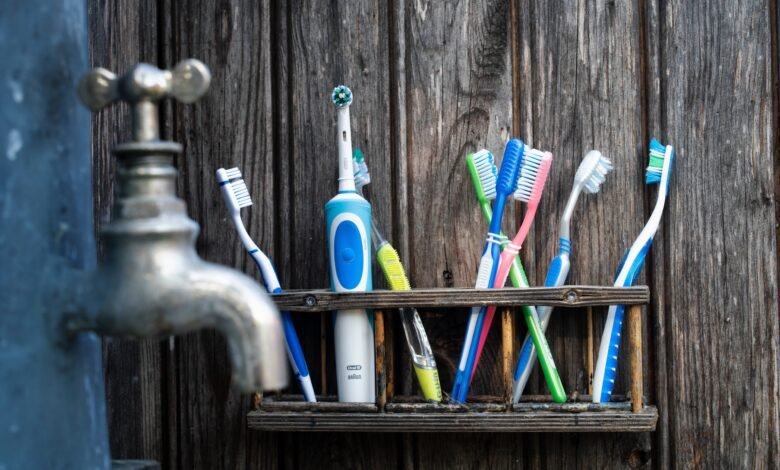Manual v powered toothbrushing in adolescent orthodontic patients – trial

The 2014 Cochrane review by Yaacob et al (Dental Elf – 18th Jun 2014) presented evidence of a small benefit for powered over manual toothbrushing in reducing plaque and gingivitis. However only a small number of studies included in the review were conducted on orthodontic patients and these were of a short duration. Consequently, the Cochrane reviewers suggested additional studies of a longer duration using a standardised methodology.
The aim of this study was to compare the efficacy of a powered versus manual toothbrushing for controlling plaque and gingival health in participants undergoing fixed orthodontic treatment in respect of both the short term and long term.
Methods
This was a randomised, parallel, controlled single-blind clinical trial, undertaken in a hospital setting. Study patients were drawn from 12–18-year-olds about to start comprehensive orthodontic treatment, with a pre-adjusted edgewise fixed appliances. Ethical approval was obtained, and the trial registered with the International Standard Randomised Controlled Trials Number (ISRCTN) registry.
Sample size was calculated to detect a full mouth plaque score reduction of 0.25. Patients were randomised to either a manual or powered toothbrush, with allocation concealment with oral hygiene instruction being provided by a research nurse independently. Patients were instructed to brush their teeth twice daily (in the morning and at bedtime) for a minimum of 2 min with the fluoridated toothpaste was supplied and encouraged to use an orthodontic interspace brush. Plaque index (PI), gingival index (GI), and bleeding on probing (BoP) were recorded. The Turesky modification of the Quigley–Hein plaque index was used for plaque scores and the Löe and Silness gingival index for gingival scores. Scores were recorded by 2 trained and calibrated researchers at baseline, 1 month, 6 months and 1 year along with an oral soft and hard tissue safety assessment.
Results
- 92 patients were randomised at baseline, 46 each to manual and powered toothbrushes groups.
- At 12 months there were 6 dropouts in the manual group and 2 in the powered toothbrush group.
- There were no significant differences were seen between powered and manual toothbrushes between GI, PI and BoP at any of the time points assessed: –
- GI [gingival index] = -0.03 (95%CI: −0.1 to 0.03).
- PT [plaque index] = 0.01 (95%CI: −0.13 to 0.14).
- BoP [bleeding on probing] = 0.003 (95%CI: -0.03 to 0.03).
- Periodontal health indicators and plaque control significantly worsened, over the 12-month follow-up period, following placement of the fixed appliances placement.
- No harms were reported or observed as a result of either intervention and no patients were removed from the study because their oral hygiene proved to be unsatisfactory,
Conclusion
The authors concluded: –
No differences have been found between a manual and sonic- powered toothbrush in controlling plaque and gingival health in participants undergoing fixed orthodontic treatment in either the short term or long term.
Comments
The authors registered their trial with the ISRCTN clinical trial registry and followed the CONSORT guidelines. A sample size calculation was undertaken based on the number required to detect a difference in full mouth plaque score of 0.25, indicating a total sample size of 80 patients. A computerised randomisation sequence was used with allocation concealment. The outcome assessors were trained and calibrated and masked to the allocation with assessments taking place at four time points the latest at 12 months. While the results demonstrated no differences between powered and manual toothbrushes the patients did deteriorate over the follow-up period which may indicate a need to improve oral health behaviours in both adolescents in general and those undergoing orthodontic treatment in particular. This trial was undertaken in a single hospital setting using one particular type of powered toothbrush so may not be generalisable so additional studies in primary care settings may be helpful.
Funding
This study received funding support from Colgate-Palmolive (USA)
Links
Primary Paper
Johal A, Shagmani M, Alfuraih O, Arad I. Long-term comparison of the efficacy of manual versus powered tooth brushing in adolescent orthodontic patients: a single-centre, parallel design randomized clinical trial. Eur J Orthod. 2023 Sep 14:cjad042. doi: 10.1093/ejo/cjad042. Epub ahead of print. PMID: 37708303.
International Standard Randomised Controlled Trials Number (ISRCTN) 37708303
Other references
Dental Elf – 4th Nov 2022
Powered toothbrushes for patients undergoing fixed orthodontic appliance treatment?
Dental Elf – 15th Dec 2017
Dental Elf – 18th Jun 2014
Powered toothbrushes reduced plaque and gingivitis more than manual toothbrushes
Picture Credits
Photo by Henrik Lagercrantz on Unsplash
Source link
#Manual #powered #toothbrushing #adolescent #orthodontic #patients #trial

